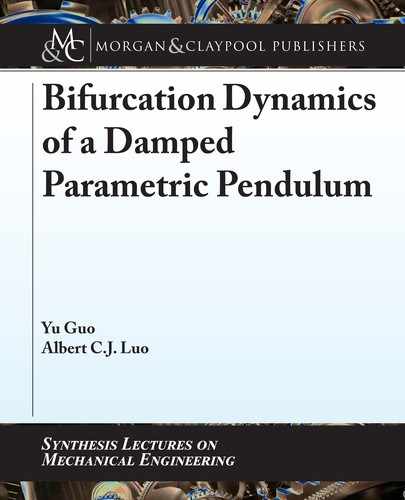22 4. BIFURCATION TREES
bifurcation are not presented owing to the tiny ranges of stable motions. Such period-1 static
point stays stable for the range 2 .2:1080; 2:8039/. At 2:1080, a saddle-node bifur-
cation occurs where the period-1 static point becomes unstable again and a pair of asym-
metric period-1 motions are generated. e induced asymmetric period-1 motions exist for
2 .1:9129; 2:1080/, which are not static anymore. Such asymmetric period-1 motions main-
tain stable until the period-doubling bifurcation at 1:9129. us, the asymmetric period-1
motions become unstable and asymmetric period-2 motions are induced. Such period-2 motions
are stable for the range of 2 .1:8949; 1:9129/. Further cascaded period-doubling bifurcations
occur at 1:8949. e induced period-4, period-8… motions are not presented owing to the
tiny ranges of the sable motions.
With excitation frequency decrease, at 1:4989, a saddle-node bifurcation of the
period-1 static-point occurs and the period-1 static-point is from unstable to stable again.
e range of the stable period-1 static-point is for 2 .1:3182; 1:4989/. e period-doubling
bifurcation of 1:3182 switches the period-1 static point back to unstable while a sym-
metric period-2 motion is produced. Such symmetric period-2 motion is stable for 2
.1:2523; 1:3182/. Such period-2 motion becomes unstable through the saddle-node bifurca-
tion of 1:2523, and a pair of asymmetric period-2 motions are introduced with a stable
range of 2 .1:2452; 1:2523/. At 1:2452, a cascaded period-doubling bifurcation occurs
for period-4, period-8… motions to chaos, as presented in Figs. 4.1e,f. As the excitation fre-
quency further decreases, two more stable ranges for the period-1 static-point can be observed.
e first one exists for 2 .0:9567; 1:0262/, which connects to the unstable period-1 static-
points through the period-doubling bifurcation at 1:0262 and the saddle-node bifurcation
at 0:9567. Stable asymmetric period-1 motions are introduced for 2 .0:9281; 0:9567/
through the saddle-node bifurcation at 0:9567. Such period-1 motions become unsta-
ble with a birth of period-2 motions after the period-doubling bifurcation at 0:9281. e
period-2 motions are stable for 2 .0:9247; 0:9281/ until the next period-doubling bifurcations
at 0:9247. e last stable period-1 static-point exists for 2 .0:7498; 0:7819/, which con-
nects to the unstable period-1 static-point through the saddle-node bifurcation at 0:7819
and the period-doubling bifurcation at 0:7498. Symmetric period-2 motion is introduced
at 0:7498 through a period-doubling bifurcation, and further cascaded period-doubling
bifurcations to chaos are observed at 0:7357.
4.2 PERIOD-1 AND PERIOD-3 MOTIONS TO CHAOS
e non-static period-1 and period-3 motions to chaos are demonstrated through the bifurca-
tion trees of period-1 to period-4 motions, as shown in Fig. 4.3 for 2 .1:0; 5:2/. Such period-1
motions are a pair of non-static asymmetric periodic motions not from the saddle-node bifur-
cations of symmetric motions. ere are two branches of travelable asymmetric period-1 mo-
tions, as shown in Figs. 4.3a,b. e first branch of the asymmetric period-1 motion is stable for
the range of 2 .3:9640; 5:2000/ and becomes unstable at the period-doubling bifurcation of

4.2. PERIOD-1 AND PERIOD-3 MOTIONS TO CHAOS 23
3:9640. Such a period-doubling bifurcation also leads to a pair of asymmetric period-2 mo-
tions which are stable for 2 .3:6691; 3:9640/. e period-doubling bifurcations at 3:6691
cause a transition of stable to unstable period-2 motions and a pair of stable asymmetric period-
4 motions for 2 .3:6405; 3:6691/. Further, a cascaded period-doubling bifurcation occurs at
3:6405, for period-8, period-16… motions to chaos. e second branch of the non-static
period-1 motions exist for 2 .1:1587; 1:2441/. Such period-1 motions are asymmetric and are
independent of a symmetric period-1 motion. At 1:2441, the saddle-node bifurcation is
the onset of the asymmetric period-1 motions. At 1:1587, the period-doubling bifurcation
of the period-1 motion is for onset of asymmetric period-2 motions. e stable period-2 motion
is for 2 .1:1378; 1:1587/ until next cascaded period-doubling bifurcation of 1:1378.
(a) (b)
Ω
Ω
π
π
π
π
π
(c) (d)
Ω
Ω
π
π
π
π
π
Figure 4.3: Period-1 motions to chaos with 2 .1:0; 5:2/: (a) displacement x
mod.k;N /
,
(b) velocity y
mod.k;N /
. Period-3 motions to chaos with 2 .2:0; 6:0/: (c) displacement
mod.x
mod.k;N /
; 2/, (d) velocity y
mod.k;N /
. (˛ D 4:0, ı D 0:1, Q
0
D 5:0.)
..................Content has been hidden....................
You can't read the all page of ebook, please click here login for view all page.
